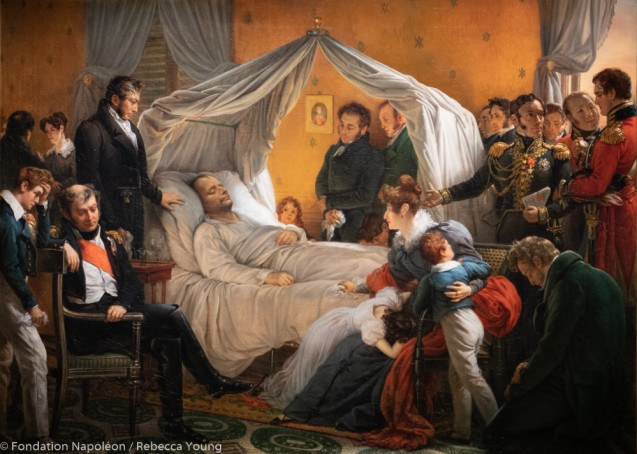On Saturday 5 May 1821 at 5-49pm, in Longwood House on the island of St Helena, ‘the mightiest breath of life which ever animated human clay’ (Chateaubriand) came no more. And it was this, ultimate moment that Steuben wished to immortalise in a painting which has since become what could almost be described as the official version of the scene. In another painting, executed during the years 1825-1830, Steuben was to give a realistic view of the Emperor dictating his memoirs to general Gourgaud. This same realism also pervades his version of Napoleon’s death, and it is totally unlike Horace Vernet’s, Le songe de Bertrand ou L’Apothéose de Napoléon (Bertrand’s Dream or the apotheosis of Napoleon) which, although painted in the same year, is an allegorical celebration of the Emperor’s martyrdom and as such the first stone in the edifice of the Napoleonic legend.
The work here is an attempt to give the most accurate representation of the scene possible. Indeed, the painter interviewed the companions of Napleon’s captivity on their return to France and had them pose for their portraits. Only the Abbé Vignali, captain Crokat and the doctor Arnott were painted from memory. The Grand maréchal Bertrand made sketches of the plan of the room, noting the positions of the different pieces of furniture and people in the room. In their bringing together of their souvenirs and their posing for the painter, each person can be seen contributing to a work of collective memory, very much with posterity in mind.
Initially forming part of the collection of the Colonel de Chambrure, the painting was put up for auction in Paris, on 9 March 1830, with other Napoleonic works, notably Horace Vernet’s Les Adieux de Fontainebleau (The Fontainebleau adieux) and Steuben’s Retour de l’île d’Elbe (The return from the island of Elba). The catalogue noted that the painting had already been viewed in the colonel’s collection by “three thousand connoisseurs” – which alone would have made it a success -, but its renown was to be further amplified by the production of the famous engraving. The diffusion of this engraving by Jean-Pierre-Marie Jazet (1830-1831, held at the Musée de Malmaison), reprinted and copied countless times throughout the 19th century, made the scene a classic in popular imagery, on a level of popularity with paintings such as Millet’s Angelus.
Karine Huguenaud (tr. P.H.)
November 2005
FACTFILE > Servants, their wives and children, the doctors, the Companions, British officers or priest… Who were the people Steuben depicted around Napoleon’s deathbed?


